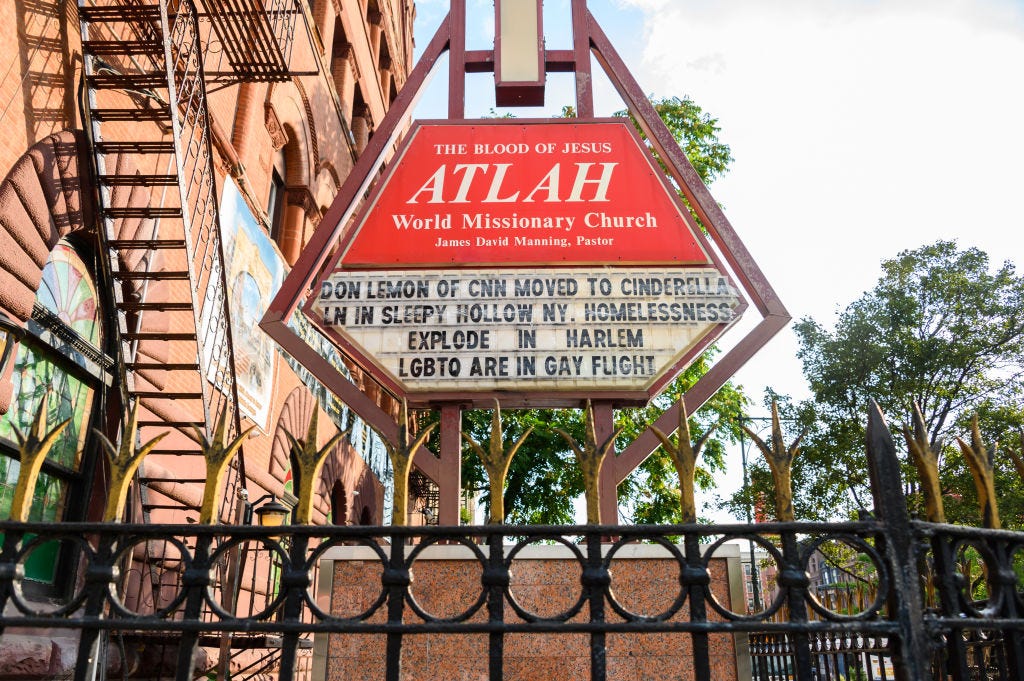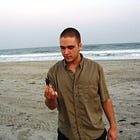What I Saw At New York’s Notorious Anti-Gay Church
Or: How to stop worrying and love thy neighbor.
“Joey, we love you,” announced the congregation of ATLAH World Missionary Church as I concluded my address to the church’s members last month. I was floored that this declaration of love came from the same flock whose pastor—James David Manning—once posted on the bright red letter board outside his Harlem church, “Jesus would stone homos.” I was even more floored that it was Manning himself who prompted them to utter it.
For about six months, I had been attending New York City’s most notorious anti-gay ministry as an openly bisexual man to bridge the divide between the LGBT community and an isolated church defined by the theatrics of its eccentric pastor. For years, I have been inspired by the work of Daryl Davis, who does exactly this type of bridge-building. Davis, a black blues musician, has saved hundreds of Ku Klux Klan members from hate through the power of connection. Earlier this year, following in his footsteps, I found my nearest anti-gay church and reached out to the pastor to ask if I could visit in a spirit of kindness and respect. He graciously agreed.
The first time I entered ATLAH, the smell of incense hit my nose as the church’s security guard patted me down to ensure I had no weapons. I noticed discolored patches on the stained glass windows where rocks had been thrown. One of the congregants explained to me that they sometimes receive mail containing inappropriate objects like dildos, as well as hateful letters. Pastor Manning keeps a rock that was thrown through a window at the foot of his podium.
When I first sat down with Manning on a pew near the front of his church, I was surprised by his respectfulness, given his outlandish rhetoric and espousal of homophobic conspiracy theories. He openly admits that he holds many unconventional beliefs, including birtherism—the belief that President Obama was born in Kenya. He told me that if I wanted to join his church, I needed to renounce the “homosexual lifestyle” (but he also told me that I would never be turned away if I chose not to).
I was struck by the fact that none of the congregants directed hatred at me. One did recoil in fear when I introduced myself as a bisexual man. But that fear soon melted into hugs and warm greetings. Now, whenever we see each other, that congregant opens her arms and embraces me with an almost childlike warmth.
What I thought was a story about “hate” is actually a story about a kind congregation sincerely convinced of the sinfulness of homosexual behavior, hanging on to every word of Manning’s weekly performances. At his pulpit—his theater stage—he recounts the church’s long-standing legal troubles with New York City and pushes his far-fetched mayoral campaign. He decries the forces he believes persecute him: Trump, Obama, the “white homosexual gentrifier,” Al Sharpton, and others. His sermons, which sometimes resemble stand-up comedy, seem to function as a kind of release valve for the congregants’ frustrations about gentrification, the cost of living, and social changes that disquiet their socially conservative sensibilities.
Listening to sermons and chatting afterward helped me build a rapport with some of the congregants. So when Pastor Manning invited me to speak before the congregation, I knew I had an opportunity to test Davis’s philosophy of curiosity over confrontation. I opted for a conciliatory approach, in keeping with the teachings of Braver Angels, a depolarization nonprofit I have been involved with for several years that brings the left and right together to disagree better.
One of the conditions that allows people to connect across groups is participation in common goals. So I littered my speech with references to, and respect for, Constitutional rights and quintessentially American norms around dialogue—such as President Lincoln’s insistence that “I don’t like that man. I must get to know him better”—to present common ground and a unified national identity.
When the time came to give the speech, I was nervous. I wondered whether the several gaping mouths I saw in the pews were expressions of awe or horror. I reminded myself of another principle that is fundamental to successful bridge-building work: that we cannot control the reactions or opinions of the people we disagree with. I labored this point to my audience, emphasizing that “the greatness of America is the fact that I can come here and share [a] different perspective—not to shame or guilt you … but to listen.”
By standing up peacefully to deliver a speech before the congregation, I functioned as an embodiment of “intergroup contact theory.” The theory, originally developed by psychologist Gordon Allport in 1954, is less about changing minds than about showcasing human complexity in a way that erodes the fears another person or group has of you.
Allport posited that consistently encountering the uniqueness of an outgroup member gently challenges the stereotypes the ingroup holds about them. Anxiety surrounding interaction with outgroup members tends to decrease with sustained contact. The theory also highlights certain conditions that are optimal for contact. One condition is that in- and out-group members should be equals. By positioning myself as someone merely seeking dialogue and connection, I eliminated the possibility that I would be perceived as an invader or coercive force undermining the congregation’s autonomy.
Nearly every faith tradition teaches of the universality of suffering and hardship. Research shows that sharing our experiences, especially deeply vulnerable ones, is highly effective at reaching people. As I approached the end of my speech, I told the congregants the story of my gay uncle who provided support to my parents when my stepmother was slowly dying from Alzheimer’s disease.
I did not merely tell a story about a gay family member who was devoted to us in a dark time. I showed how my family would be less whole if our culture did not accept gay relationships. I ended by asking the congregation to find the complexity in the LGBT community I had come to find in them. In doing so, I offered the love Christ called “agape.”
As I exited the church, members of the congregation stood up to greet me. Many shook my hand and approached me to talk with great enthusiasm.
Four days after I delivered my speech, Charlie Kirk was assassinated on a college campus in Utah. The bullet that pierced his throat also tore a hole in our civic fabric. At times, the reaction in the press, politics, and on social media felt like a mix of celebrating violence and finger-pointing across the aisle.
Yet a flurry of media coverage and calming public voices, like Governor Spencer Cox of Utah, also called for more Americans to actively build bridges to heal toxic polarization and stop the cycle of political violence before it becomes more extreme. He was right. The cultural fissures on display after the tragedy will only lead to more violence unless they are healed through deliberate efforts to connect with our fellow Americans, and build what social scientist Robert Putnam calls “bridging social capital”—ties between groups that do not normally engage with each other.
This work will take years, if not decades. It will involve a deliberate effort on the part of individual Americans to embrace one another across ideological differences. The timeframe for addressing polarization may seem daunting. After all, movements for African American emancipation, such as the abolition of slavery, and the subsequent Civil Rights Movement, spanned centuries. Yet the early 17th century Quakers, who were among the first abolitionists, would be amazed by the 13th Amendment and modern civil rights laws.
These accomplishments were not the result of any one person, but rather the culmination of millions of people adopting beliefs about human freedom over generations. Population-level changes in mindset have happened in this country before. By deliberately resetting our view of ideological rivals to one of curiosity rather than condemnation, contemporary Americans can liberate each other from ignorance—and violence.
Joey T. McFadden is a writer & commentator with Young Voices, host of “In Response…,” and Blue Co-Chair of the Braver Angels NYC Alliance. See his paintings on Instagram.
Follow Persuasion on Twitter, LinkedIn, and YouTube to keep up with our latest articles, podcasts, and events, as well as updates from excellent writers across our network.
And, to receive pieces like this in your inbox and support our work, subscribe below:








Clicking on a heart icon was insufficient. I needed to drop a comment to say that I loved the heck out of the piece.
Yes, confirms my experiences.
As a workplace trainer and management consultant, I worked in the largest cities in the United States as well as in small rural communities. I learned that there were towns I visited where few of the people had ever met a Jew. So, regardless of the topic of my class, I would find a way to weave a family story into my introduction. (I thank my colorful immigrant relatives for giving me lots of material.) Then, I would tell my audience that, by the way, I would not take offense at any question or consider it anti-Semitic.
The very first time, during a meal at a retreat for a group of college-educated teachers and social workers in rural Minnesota, I was asked when Jews stopped using Christian babies in human sacrifice. Although I am not an observant Jew, I had done my homework and did an okay job of explaining the early history of the "blood libel." That satisfied the group. But the shock came was when they learned that I didn't accept Jesus as my savior. For some, that was not forgivable.
And there was the Kansas library director who wept over dinner because I am going to hell.
Ironically, those experiences also prepared me to work and live among left- and right-leaning neighbors and colleagues as a libertarian. While I was working, going back over 40 years, I rarely discussed politics with my clients except to find points of agreement where I could commiserate with them without trying to change anyone's mind. I would sometimes offer a "what if" or an "on the other hand", but I mostly listened, even when my beliefs were denigrated and even booed from a podium or audience. The few times I came out were mostly not pleasant.
Now retired, or, as I like to call it "reset", I still tell outrageous family stories–my uncle Charlie's taking bets for the Chicago mobs or my grandfather coming to America hidden in a burlap bag in steerage marked "sausages." And I find a way, when discussing the political circus playing out on a hundred stages, to add a note regarding my views as a classical liberal, committed to entrepreneurship, voluntary solutions, and choice. And we talk.
I have lost some friends, but made new ones. And one of my neighbors told me a few days ago that her opinionated teenage son, who identifies as a Socialist, spoke well of me to his friends as someone he could talk to. High praise indeed.